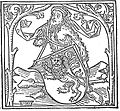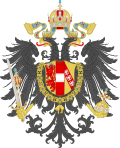Štítonoš
Štítonoši jsou v heraldice jedna až dvě figury, živé bytosti, které nesou, pozdvihují, podpírají nebo se opírají o erb a tvoří tak součást jeho dekorace. Obvykle jsou zobrazovány ve dvojici, stojící, sedící nebo ležící po obou stranách erbu, výjimečně je můžeme spatřit i za erbem (sloni ve znaku Konžské republiky) nebo pod erbem.
Počet
- dva stejní, symetricky pojatí
- dva různí nesymetričtí
- jeden, např. dvojhlavý orel, která má znak na hrudi – znak dnes již neexistující Svaté říše římské, později Rakouska do konce I. světové války).
Druh
- reálné lidské bytosti - rytíři, trubači, Mauři, Turci
- mytologické bytosti - diví muži, divé ženy, atlanti, mořské panny
- andělé
- heraldická zvířata
Volba a typ štítonoše mohou být dány tradičními bájemi, legendami spojenými s držitelem erbu (někdy to je zvíře přímo v erbu zobrazené), jako dvouocasí lvi v již zaniklém znaku Československé republiky z roku 1920 nebo lvi na znaku Anglie.
Pozice
Štítonoši mohou
- stát na půdě, v určitých případech na stuze hesla.
- stojí vzpřímeně a frontálně.
- stojí vzpřímeně a natočeni tělem k sobě
- kráčet a nést erb v rukou nebo zavěšený na šňůře, jako se to konalo při slavnostních přehlídkách
- čtvernožci mohou stát na všech nohou, nebo kráčet po zadních, nebo se vzpínat na zadních (kůň či jednorožec ve skoku)
- ptáci a gryfové mohou znak přidržovat zobákem, nebo se o něj jen břichem opírat (například emu na znaku Austrálie)
- ryby, delfíni a velryby se zobrazují s hlavou na půdě a s tělem esovitě vzhůru stočeným
- andělé mohou letět (například na některých erbech Uherska nebo města Plzně), poklekat (na erbovních listinách ze 16. století)
Používání
Štítonoše mohou užívat státy, města, obce, panovníci a vysoká šlechta, v občanských znacích se užívat nemají.
Galerie
- Divý muž jako štítonoš (1477)
- Dvojhlavý orel na malém znaku rakouského císaře nesoucí štít na hrudi
- Dva gryfové nesoucí znak Rakouska (1915)
- Klokan a emu, štítonoši Austrálie
- Velryby na znaku města Zaanstad
- Dva zlatí lvi, štítonoši státního znaku Nizozemska
Odkazy
Externí odkazy
 Obrázky, zvuky či videa k tématu štítonoš na Wikimedia Commons
Obrázky, zvuky či videa k tématu štítonoš na Wikimedia Commons
Média použitá na této stránce
Autor: Sodacan, Licence: CC BY-SA 3.0
Imperial Coat of Arms of the Empire of Austria, used from 1815 to 1866.
Generic coat of arms.
Middle Coats of arms of Austrian Countries, designed in 1915, official draft Hugo Gerhard Ströhl. — Background transparency
Commonwealth Coat of Arms of Australia granted by Royal Warrant signed by King George V on 19 September 1912.
IMPORTANT:This image is an artist's interpretation of the original (1912) official version of the Commonwealth Coat of Arms shown in Commons on the Australian coat of arms page. A variant of the original, with a transparent background, is shown on this page.
| “ | Quarterly of six, the first quarter Argent a Cross Gules charged with a Lion passant guardant between on each limb a Mullet of eight points Or; the second Azure five Mullets, one of eight, two of seven, one of six and one of five points of the first (representing the Constellation of the Southern Cross) ensigned with an Imperial Crown proper; the third of the first a Maltese Cross of the fourth, surmounted by a like Imperial Crown; the fourth of the third, on a Perch wreathed Vert and Gules an Australian Piping Shrike displayed also proper; the fifth also Or a Swan naiant to the sinister Sable; the last of the first, a Lion passant of the second, the whole within a Bordure Ermine; for the Crest on a Wreath Or and Azure A Seven-pointed Star Or, and for Supporters dexter a Kangaroo, sinister an Emu, both proper. | ” |
Autor: arcjgh, Licence: CC BY 2.5
A SVG version of the Netherlands Coat of Arms
Wilder Mann mit umgehängtem Wappen















